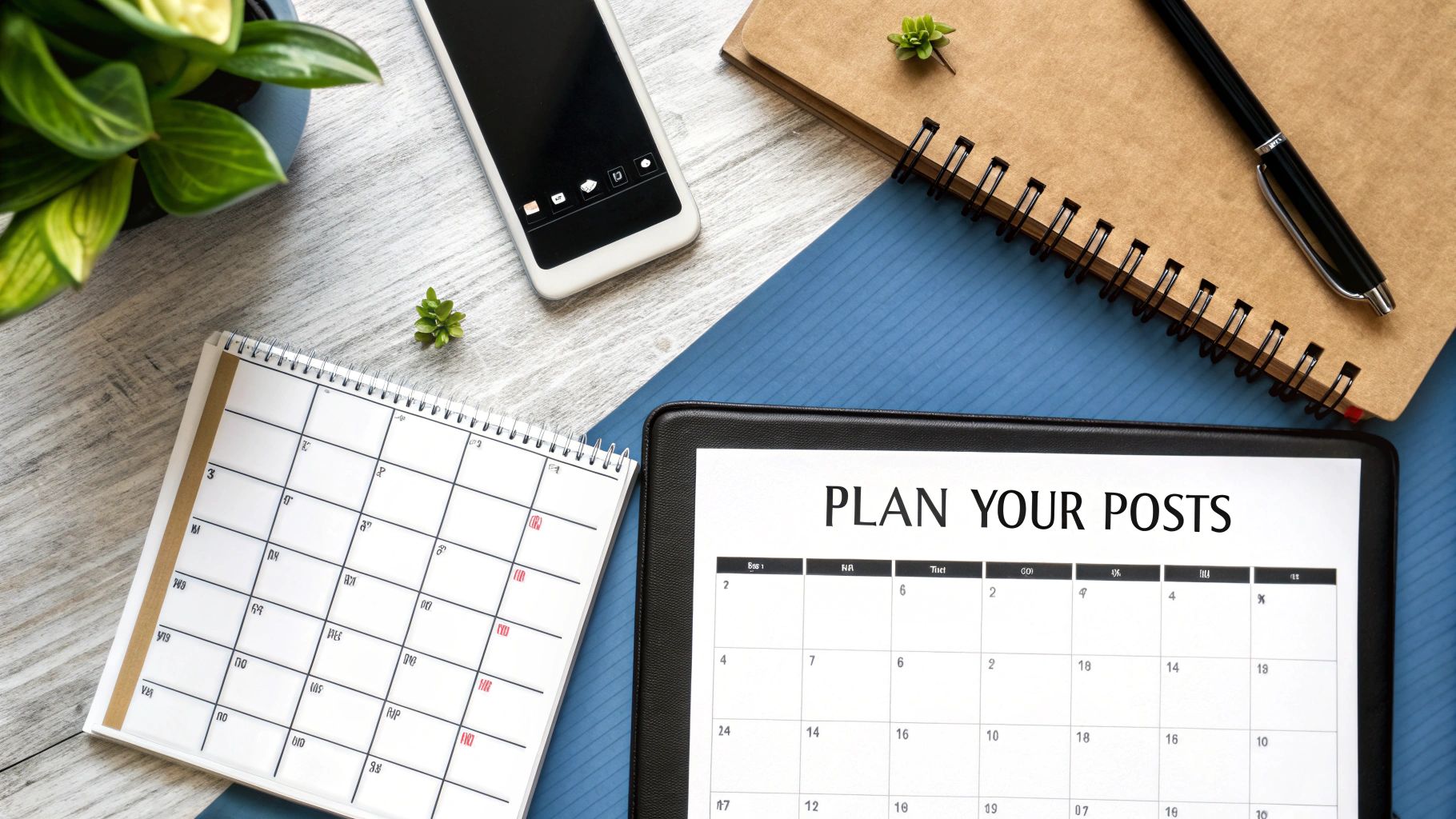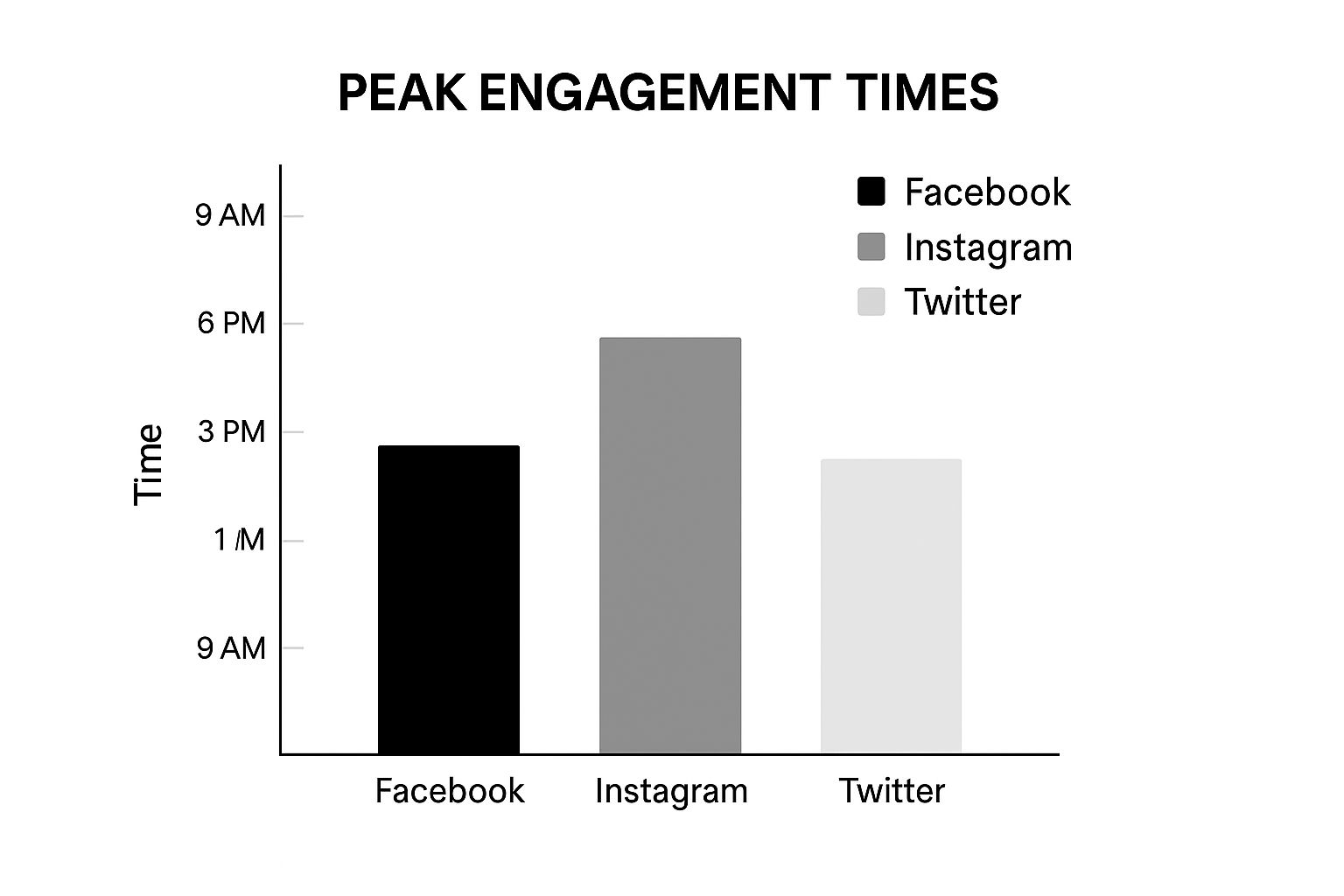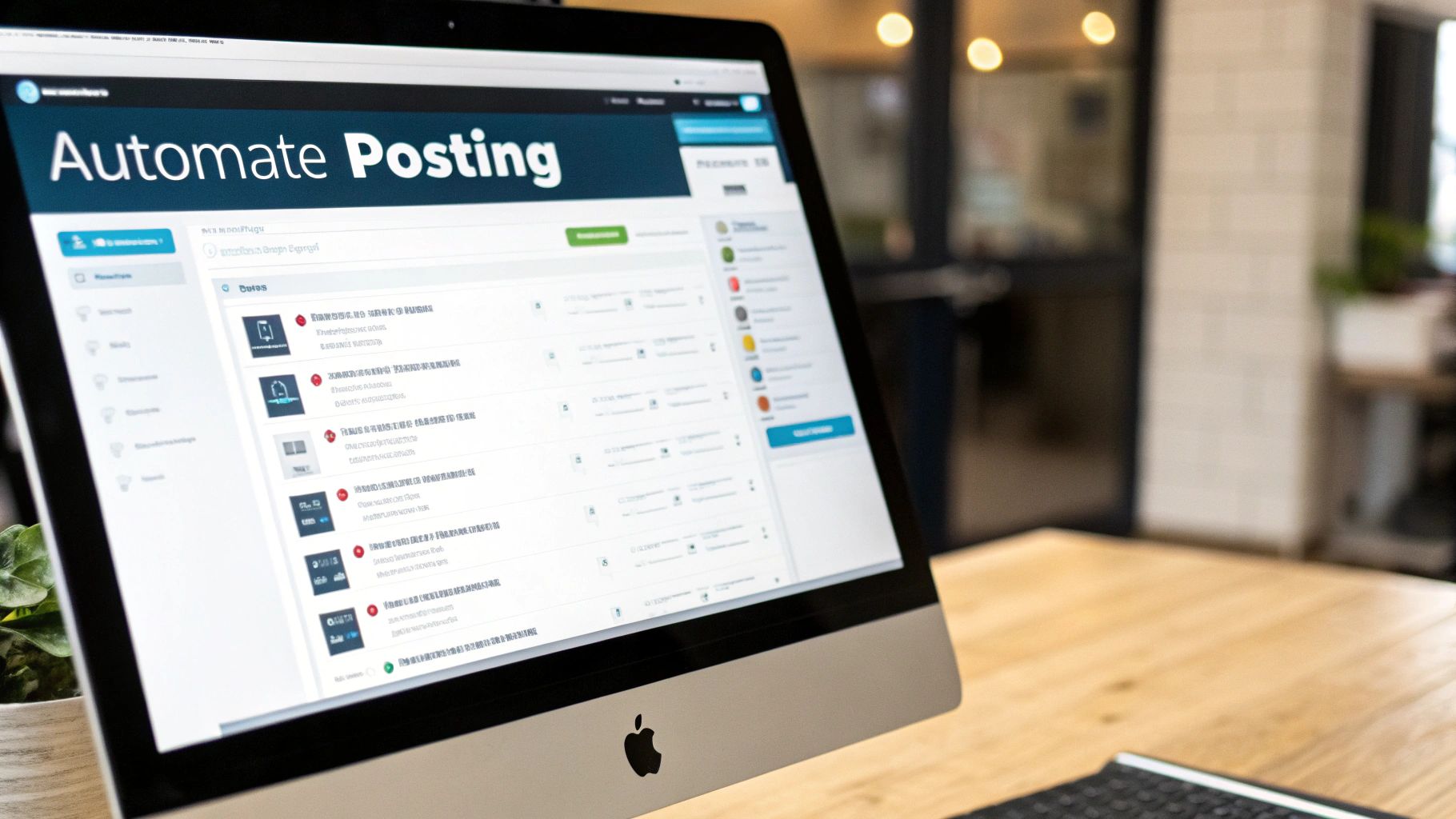Social Media Scheduling Tips for Maximum Engagement
TL;DR - Quick Answer
36 min readTips you can use today. What works and what doesn't.
Social Media Scheduling Tips for Maximum Engagement
Understanding Modern Social Media Scheduling Success
Social media scheduling has changed. It's not just about automating posts anymore. It's about strategically planning your content to get real, measurable results. While consistent posting is important, real success comes from understanding your audience, engaging with them authentically, and timing your posts strategically. It's about creating a cohesive and engaging presence on social media, not just filling a queue.
Beyond Automation: Strategic Content Orchestration
Think of social media scheduling like conducting an orchestra. Each instrument (social media platform) has its own unique part to play, and the conductor (your scheduling tool) brings them all together in harmony. Just as a conductor carefully times each musical phrase, effective social media scheduling involves strategically timing your posts to reach the right audience at the right time. This means understanding your audience's behavior – when they're online, what content they like, and which platforms they prefer.
Timing Is Everything: Understanding Your Audience
Imagine you're launching a new product. Simply scheduling one post across all platforms at the same time might not be effective. Instead, think about a staggered approach, tailoring your message and timing for each platform's specific audience. Knowing peak engagement times is also key. You don't want your big announcements getting lost in a sea of other posts.
Pro Tip: Use our Best Posting Time Calculator to discover the optimal times to post for your specific audience and industry. This free tool analyzes platform algorithms and audience behavior patterns to recommend personalized posting schedules that can increase your engagement by up to 150%.
Social media scheduling is increasingly focused on multi-platform strategies, allowing businesses to reach wider audiences. Managing multiple platforms can be tough, but scheduling tools like Hootsuite or Buffer help streamline content distribution. This ensures consistent branding across platforms like Instagram, Facebook, Twitter, and LinkedIn, boosting visibility and engagement. By 2025, the average person is expected to use 6.83 different social networks each month, spending an average of 2 hours and 21 minutes per day on these platforms. This highlights the importance of coordinated, multi-platform scheduling to maximize reach. Find more detailed statistics here: Discover more insights about social media usage
From Manual Posting to Strategic Marketing
Manually posting often fails to deliver consistent results. It's time-consuming and makes it hard to maintain a regular posting schedule, especially across multiple platforms. Scheduling tools free up your time, allowing you to focus on strategy, content creation, and audience engagement. This shift from reactive posting to proactive planning is essential for modern social media success. This strategic approach helps you build a stronger online presence and achieve your marketing goals more effectively.
Leveraging Data Analytics for Optimal Timing Strategies

Social media scheduling isn't about throwing posts out there and hoping for the best. It's about using data to turn guesswork into a precise strategy. This data-driven approach helps businesses pinpoint when their audience is most engaged and analyze what's working and what's not. Imagine knowing exactly when your audience is most active on Instagram versus Facebook. This knowledge lets you tailor your posting schedule for maximum impact on each platform.
Identifying Peak Engagement Windows
One of the best ways to use data analytics is by identifying peak engagement windows. These are the specific times when your audience is most likely to interact with your content. This isn't about general rules like "weekdays are better." It's about using your own audience data to understand their specific online habits. It's like finding the best fishing spot; you need to know where the fish are biting.
Tools like Facebook Insights and Twitter Analytics can help you pinpoint these crucial times. Many third-party social media scheduling tools also offer in-depth analytics for finding optimal posting times. This data-driven approach helps ensure your content is seen when it's most likely to get engagement. This targeted strategy maximizes reach and interaction.
One growing trend in social media scheduling is the importance of using data analytics to optimize posting times. By analyzing engagement patterns, businesses can tailor their schedules for maximum reach and interaction. For example, by 2025, an estimated 73.99% of internet users in the United States will regularly use Facebook, alongside a projected global social media user base of 5.42 billion. Learn more about these social media statistics here. Using analytics effectively helps businesses stand out online.
Analyzing Performance Patterns
Data analytics goes beyond just finding the best posting times. It also reveals deeper engagement patterns. This means looking past basic metrics like likes and comments. It's about understanding why certain posts do better than others. Do videos get more shares than images? Do questions generate more conversation?
Adapting Your Schedule Based on Behavioral Data
Data analysis isn't a one-and-done activity. Social media platforms and user behavior are always changing. This means your social media scheduling strategy needs to be flexible. By continuously monitoring your analytics, you can identify new trends and adjust your posting schedule.
For example, if you see a shift in your audience's peak activity times, you can adapt your schedule to match. This ongoing optimization helps you maintain consistent reach and maximize your content's impact. This dynamic approach is essential for long-term social media success. It's all about continually learning and adapting to stay on top of things.
AI-Powered Scheduling For Smart Automation

Artificial intelligence is rapidly changing how we schedule social media. It's no longer just about automating posts. It's about using AI to make smarter decisions about when and what to post for maximum impact. AI-driven tools analyze massive datasets, helping you reach your target audience more effectively.
Predicting Optimal Posting Times
Imagine a tool that not only schedules your posts but also tells you the best time to post them. That's the power of AI. AI algorithms analyze historical data, current trends, and real-time engagement. This helps pinpoint the best times when your audience is most likely to see and interact with your content.
This precision targeting boosts engagement and helps your content stand out. It's a level of accuracy far beyond what traditional scheduling methods could achieve. You can now focus on creating engaging content instead of manually analyzing complex data.
AI-powered scheduling also helps you adapt to the ever-changing algorithms of different social media platforms like Facebook, Instagram, Twitter, and LinkedIn. This ensures your posts always have the best chance of being seen.
AI-Driven Content Suggestions
AI's impact goes beyond timing. Some advanced tools use AI to suggest content improvements. These tools can analyze your past successful posts and identify trending topics relevant to your industry. They can even help you write better captions.
This means AI can assist in the creative process, offering valuable insights. It gives social media managers a powerful new tool to enhance their work.
Automating Complex Scheduling Decisions
Managing multiple social media accounts across different platforms can be a challenge. AI simplifies this process significantly. Think about juggling posting schedules for various platforms. AI can automate these complex decisions, ensuring a consistent and optimized presence across all your channels.
This includes tailoring content for each platform, automating posting frequency, and even adjusting schedules based on real-time events or trends. This intelligent automation frees up time for marketers to focus on strategic planning and creative content development. It's about finding the right balance between automation and the human touch.
SocialRails can help automate your social media presence so you can focus on growing your business. It provides a central hub for scheduling across multiple platforms and streamlines your workflow. By the end of 2024, the AI market expanded to over $184 billion U.S. dollars. Find more statistics here. This demonstrates the growing importance of AI in digital marketing.
Essential Social Media Scheduling Tools That Actually Work
Choosing the right social media scheduling tool can feel overwhelming with so many options. This post analyzes the most effective platforms based on actual user experience and results, not marketing hype. We'll explore free and paid tools, evaluating their strengths, integrations, and weaknesses. We'll also include insights from real marketing teams on which tools work best for different needs, like scheduling posts in bulk or working together as a team.
Key Features to Consider
Top Tools: A Comparative Overview
To help you choose the right tool, we've compiled a comparison of some leading social media scheduling platforms. The table below details key features, pricing, and ideal use cases.
Top Social Media Scheduling Tools Comparison: A comprehensive comparison of leading scheduling platforms showing key features, pricing, and best use cases
As you can see, each tool offers a unique mix of features and pricing. Consider your specific needs and team size when making your decision.
Optimizing Your Schedule With Data
Effective social media scheduling depends on knowing your audience. Peak engagement times are different for every platform. The infographic below shows peak times across three popular platforms.

The infographic highlights that Facebook sees the most engagement at 9 AM, Instagram at 1 PM, and Twitter at 7 PM. This data shows why tailoring your posting schedule to each platform is so important. Using analytics tools like Facebook Insights or Twitter Analytics can help you pinpoint your audience's peak engagement times. This data-driven approach ensures strategic timing, maximizing your content's reach. Consistent posting is good, but strategic timing is what makes your social media presence truly stand out.
Choosing the Right Tool for Your Business
The best tool for you depends on your specific needs and budget. Startups might prefer free tools like Buffer or Later, while larger businesses could consider Hootsuite for its multi-platform features. Large companies often benefit from Sprout Social's comprehensive tools. Think about factors like team size, how many social media accounts you manage, and what level of analytics you need. Don't make the mistake of choosing a tool based only on price or features. Think about the total cost, including training and possible integration issues.
Switching tools can be disruptive, so choose a platform that can grow with your business. Social media scheduling is an ongoing process, requiring tweaks and adjustments along the way.
Creating Content Calendars That Drive Consistent Results

A well-structured content calendar is essential for successful social media scheduling. Many businesses, however, find creating a practical and effective calendar challenging. This section explores building content calendars that deliver tangible results. We'll cover proven frameworks for organizing content, balancing different post types, and planning multi-platform campaigns without overwhelming your audience.
Organizing Content Themes and Topics
A successful content calendar relies heavily on the organization of themes and topics. This involves grouping similar content to create a cohesive narrative over time. For instance, a fitness brand might dedicate Mondays to workout tips, Wednesdays to healthy recipes, and Fridays to motivational stories.
This thematic approach offers consistency and builds anticipation among followers. It also simplifies content creation by providing a clear structure for each day or week, allowing you to prioritize quality content.
Balancing Promotional and Educational Content
Promoting products or services is important, but a content calendar shouldn't focus solely on sales. Educational and engaging content builds trust and positions you as a valuable resource.
Finding the right balance between promotional and educational posts is key. Consider the 80/20 rule: 80% valuable content and 20% promotional messages. A software company, for example, could share tips and tricks related to their product alongside occasional announcements about new features or discounts. This balanced approach keeps your audience engaged without feeling bombarded by sales pitches, fostering stronger connections and long-term loyalty. Research shows that businesses using structured content calendars see 67% higher engagement rates and 58% more consistent posting frequency. Find more detailed statistics here.
Planning Multi-Platform Campaigns
Campaigns spanning multiple platforms maximize reach and impact. However, tailoring your message to each platform's audience is crucial. A tweet might be short and attention-grabbing, while an Instagram post could benefit from a visually compelling image or video. This tailored approach ensures your message resonates effectively. Using a tool like SocialRails simplifies multi-platform scheduling, allowing you to manage all your accounts from a central dashboard.
Building a Flexible Content Calendar
While planning is essential, a rigid content calendar can hinder creativity and responsiveness. Building flexibility into your calendar is crucial. This means leaving room for spontaneous posts and real-time engagement. Think of your calendar as a guide, not a strict itinerary. This adaptable approach allows you to capitalize on unexpected opportunities and stay relevant. It also enables you to react to current events or industry news, positioning you as a thought leader.
Collaborative Planning and Seasonal Content
Creating a content calendar shouldn't be a solo effort. Involving your team fosters collaboration and ensures everyone aligns with the overall social media strategy. Platforms like SocialRails offer collaborative features for content creation, scheduling, and approvals. This streamlines workflow and keeps everyone informed. Furthermore, incorporating seasonal trends into your calendar keeps your audience engaged year-round. This proactive approach ensures timely content and strengthens your audience connection. Planning engaging campaigns well in advance maximizes their impact.
Measuring Success and Optimization Strategies That Matter
Creating and scheduling content is only half the battle. Measuring its impact and continuously improving is where real success lies. This section explores the metrics that truly matter for social media scheduling effectiveness, moving beyond vanity metrics like likes and followers. These might look impressive, but they don't always translate to business results. Instead, we'll focus on identifying the engagement patterns that indicate long-term growth.
Tracking Engagement Patterns
True social media success isn't about fleeting popularity; it's about building lasting connections. This requires understanding how your audience interacts with your content over time. Are they sharing your posts? Are they commenting and starting conversations? Are they clicking through to your website?
These engagement metrics are far more valuable than simple likes because they signal genuine interest and potential for conversion. Tracking these patterns reveals what resonates with your audience, helping you refine your content strategy for greater impact. This means you can focus on creating content that truly connects, leading to stronger relationships and increased brand loyalty.
For example, a high click-through rate on posts with links to your website demonstrates the effectiveness of your social media strategy in driving traffic and potential sales.
Analyzing Posting Performance for Optimization
Data analysis is key to understanding what works and what doesn't. Look closely at the performance of individual posts to identify optimization opportunities. Which posts generated the most engagement? Which ones fell flat? Analyzing these patterns helps uncover the types of content, posting times, and hashtags that resonate best.
Additionally, you can use A/B testing to experiment with different posting times, content formats, and calls to action. This data-driven approach allows you to refine your social media scheduling strategy for maximum impact. This continuous optimization is crucial for maintaining a strong and engaging social media presence.
Developing Systems for Continuous Improvement
Social media is constantly evolving, so your strategy needs to adapt. Regularly review your social media scheduling analytics to identify emerging trends and adjust your approach. Are engagement rates declining on a specific platform? Are certain types of content performing better than others?
Key Metrics and Optimization Tips
The following table, "Key Social Media Scheduling Metrics," summarizes essential Key Performance Indicators (KPIs) to track and provides optimization tips for your social media scheduling strategy. This information is essential for optimizing your social media presence and achieving your marketing goals.
This table provides a clear overview of the essential metrics you should be tracking. By focusing on these key metrics and continuously optimizing your strategy, you can achieve meaningful results and build a strong online presence. This ongoing process of measurement and refinement is essential for maximizing your social media impact.
Key Takeaways For Social Media Scheduling Excellence
This section offers a practical guide to effective social media scheduling, using actionable insights and proven strategies from successful brands. We'll break down key concepts into clear, actionable steps you can use right away to boost your results. Each takeaway focuses on strategies that deliver tangible business outcomes, outlining realistic timelines and clear indicators of success that you can monitor.
Strategic Checklist for Scheduling Success
For social media scheduling excellence, use this checklist:
- Tool Selection: Pick a tool that fits your business needs and budget. Think about factors like team size, how many social media accounts you manage, and the level of analytics you need.
- Content Planning: Create a structured content calendar that balances promotional and educational posts, incorporating seasonal trends.
- Analytics Implementation: Track key metrics like engagement rate, reach, and click-through rate to learn what your audience responds to and improve future content.
- Ongoing Optimization: Regularly review performance data and adjust your scheduling strategy to maintain optimal engagement and reach.
This checklist helps you build a successful social media scheduling strategy. It highlights the importance of planning, analysis, and continuous improvement.
Avoiding Common Scheduling Pitfalls
Many businesses stumble into common traps that limit their social media scheduling effectiveness. Here's how to avoid them:
- Inconsistent Posting: Stick to a regular posting schedule to keep your audience engaged and build a consistent online presence. Scheduling tools can automate this.
- Ignoring Analytics: Don't just schedule posts and forget about them. Analyze performance data to see what's working and what isn't. Use those insights to refine your approach.
- Lack of Platform-Specific Strategies: Adapt your content and posting times to each platform's unique audience and algorithm. A one-size-fits-all strategy rarely succeeds.
- Over-Automation: While automation is useful, keep a human element in your posts. Interact with your audience authentically and respond to comments and messages.
Avoiding these pitfalls helps maximize the effect of your social media scheduling.
Scaling Your Scheduling Efforts
As your business grows, your social media scheduling needs to grow with it. Here's how to ensure a smooth transition:
- Invest in Advanced Tools: Consider upgrading to a premium scheduling tool with features like bulk scheduling, team collaboration, and in-depth analytics.
- Refine Content Creation Processes: Develop efficient workflows for content creation, approval, and scheduling.
- Delegate Responsibilities: Assign clear roles and responsibilities to team members to manage the increased workload.
This structured approach helps your social media scheduling stay effective as your business expands.
Maintaining Quality While Increasing Output
Expanding your social media presence shouldn't mean sacrificing quality. Here's how to maintain high standards:
- Focus on Value: Prioritize creating valuable, engaging content that your audience connects with. Don't just focus on quantity over quality.
- Leverage Templates and Automation: Use templates for common post formats and automate repetitive tasks to free up time for more creative content development.
- Maintain Brand Consistency: Ensure your social media content aligns with your brand voice and messaging.
Following these guidelines lets you scale your social media presence while maintaining a strong brand and delivering high-quality content.
Staying Ahead of Platform Changes
Social media platforms constantly evolve. Here's how to stay adaptable:
- Monitor Industry News: Stay updated on platform updates and algorithm changes. This lets you adjust your strategy proactively.
- Experiment and Test: Don't hesitate to experiment with new features and content formats. A/B testing can help you discover what works best.
- Engage with Your Audience: Pay attention to audience feedback and adjust your content accordingly.
By staying informed, adaptable, and connected with your audience, you can navigate platform changes and keep a strong social media presence.
Frequently Asked Questions
What are the best times to post on social media?
Best posting times vary by platform and audience. Generally, Facebook performs best at 9 AM, Instagram at 1 PM, and Twitter at 7 PM. However, use your own analytics to find when your specific audience is most active, as this varies by industry, location, and demographics.
How far in advance can I schedule social media posts?
Most scheduling tools allow you to schedule posts weeks or months in advance. However, it's best to schedule no more than 2-4 weeks ahead to maintain relevance and allow for real-time adjustments based on current events or trends.
Should I use the same posting times for all social media platforms?
No, each platform has different peak activity times and user behaviors. Instagram users are often active during lunch breaks, LinkedIn users are more active during business hours, and TikTok users are active in the evenings. Tailor your scheduling to each platform's audience patterns.
How often should I post on social media?
Posting frequency varies by platform: Instagram 1-2 posts per day, Facebook 1-2 posts per day, Twitter 3-5 tweets per day, LinkedIn 1 post per weekday. Consistency is more important than frequency, so choose a schedule you can maintain long-term.
Can scheduling tools post to Instagram automatically?
Yes, many scheduling tools now offer automatic posting to Instagram for both feed posts and Stories. However, some advanced features like tagging locations or people may require manual posting or have limitations depending on your account type.
Is it better to post manually or use scheduling tools?
Scheduling tools are generally better for consistency and time management. They allow you to batch create content and maintain regular posting even when busy. Manual posting is only preferable for real-time engagement and responding to current events.
How do I choose the right social media scheduling tool?
Consider your budget, team size, number of platforms you use, and required features like analytics, collaboration tools, or bulk uploading. Start with free tools like Buffer or Later if you're just beginning, and upgrade to premium tools as your needs grow.
Does scheduling posts hurt engagement rates?
No, scheduling posts doesn't hurt engagement rates if you're posting at optimal times and maintaining quality content. However, you should still engage manually by responding to comments and messages promptly to maintain authentic audience relationships.
Can I schedule posts for multiple social media accounts at once?
Yes, most modern scheduling tools allow cross-platform posting where you can publish the same content to multiple platforms simultaneously. However, it's better to customize content for each platform's specific format, audience, and best practices.
What's the difference between free and paid scheduling tools?
Free tools typically limit the number of accounts, posts per month, or advanced features like detailed analytics and team collaboration. Paid tools offer more accounts, unlimited scheduling, advanced analytics, team features, and priority customer support.
Related Social Media Scheduling Resources
- How to Schedule Instagram Stories - Complete Instagram Stories automation guide
- Best Apps to Schedule Instagram Posts - Top Instagram scheduling tools compared
- How to Post on Instagram from Mac - Desktop Instagram posting methods
Ready to simplify your social media and grow your business? SocialRails offers a powerful platform for scheduling across multiple platforms, generating content, and managing all your social media from a single dashboard. Start growing your audience and saving time today!
Article created using Outrank
Was this article helpful?
Let us know what you think!
